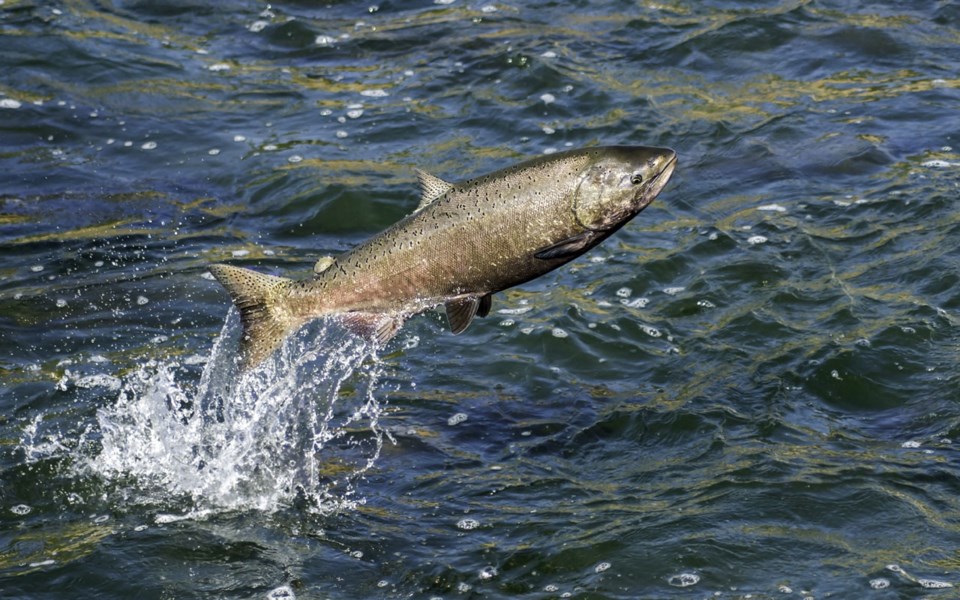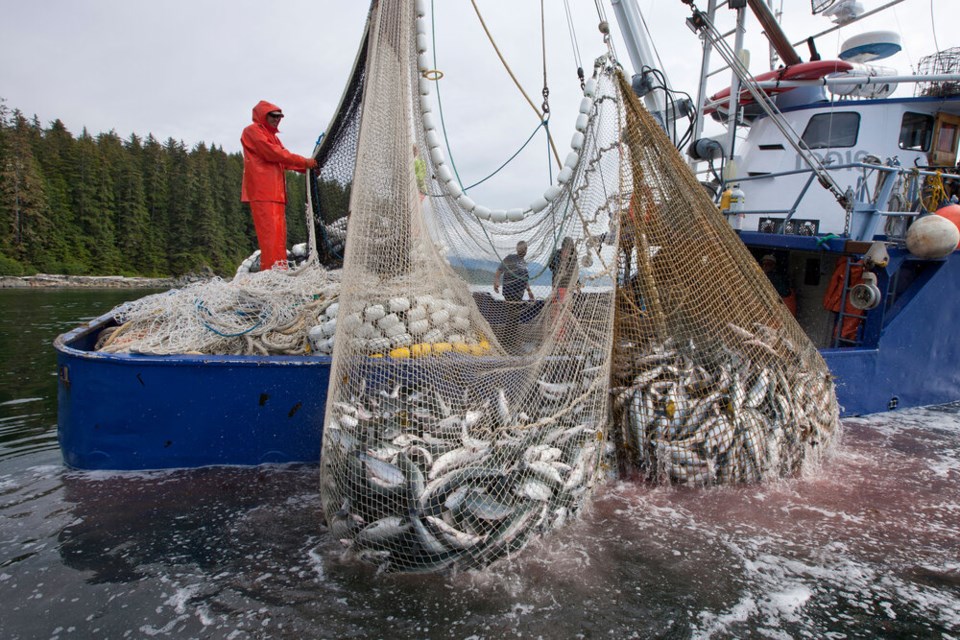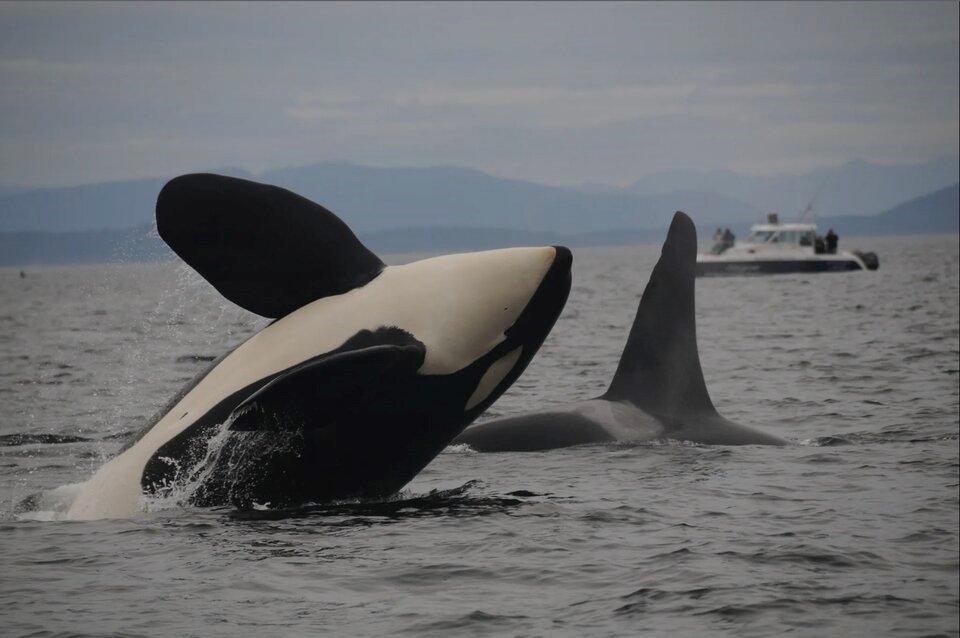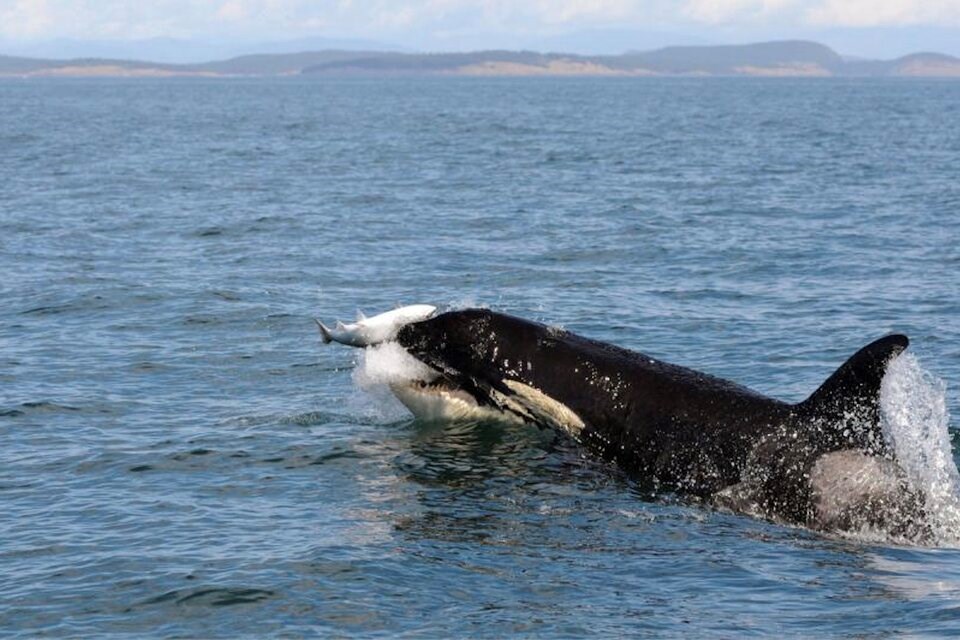A U.S. federal judge has thrown out a key authorization that has allowed a fishery in southeast Alaska to intercept hundreds of thousands of chinook salmon — long before they can reach endangered southern resident killer whales in B.C.
U.S. District Judge Richard Jones vacated the permits after finding federal government plans to protect salmon from fishing were too vague and contributed to starving the southern resident killer whale population, violating laws protecting the endangered species. From a Seattle courtroom, Jones the National Marine Fisheries Service to redo a biological opinion required for the fishery to take place.
The ruling effectively shuts down the summer and winter chinook troll fishery stretching off the coast of the Alaska panhandle — waters where roughly 97 per cent of the fish caught are bound for home rivers in B.C., Washington and Oregon, according to Wild Fish Conservancy, which filed the lawsuit.
"It's an enormous ruling," said executive director Emma Helverson. "We haven't seen any meaningful actions to address prey availability in decades."
Ranging from California to B.C., the southern residents' numbers have stagnated at 73 individuals in recent years. The most recent analysis from Fisheries and Oceans Canada shows they face a 24 per cent chance of functional extinction as early as 75 years from now.
The whales face several threats — from industrial toxins to collisions with boats and acoustic disturbances due to vessel traffic. But while port authorities and federal agencies on both sides of the border have moved to give the animals more space, little has been done to ensure they have enough chinook salmon, the animal's primary food source.

鈥婣s a result of the ruling, 172,000 chinook that would have been harvested or indirectly killed in Alaska are expected to continue their journey south, where they will spawn in watersheds across Vancouver Island the B.C. Mainland and up the Columbia River in the U.S.
The arrival of the fish would represent roughly a five per cent boost in the availability of prey for the southern resident killer whales, just enough to allow the population to stabilize but not grow, according to an to the court from Robert Lacy, a conservation scientist with the Chicago Zoological Society.
"That really shows just how that over-harvest that was being authorized for so long was impacting the whales," said Helverson.
Alaska, fishing group file appeals
On Wednesday, the State of Alaska issued a statement saying it would appeal the ruling and request a stay to allow the summer fishing season to go ahead.
Alaska governor Michael Dunleavy issued a saying Alaska "will not tolerate the suspension of its fisheries" while fisheries in other jurisdictions continue.
"If this decision sticks, we will be looking at having all fisheries that affect these killer whales being treated equally under the law," he said.
Reached in Juneau, Amy Daugherty, the Alaska Trollers Association executive director, confirmed to Glacier Media that the group had filed its own appeal.
"We are looking into whatever it takes to operate our fisheries this July," she said.
Daugherty says preventing the chinook fishery from going ahead this summer would stall the livelihoods of roughly 1,000 active permit holders, the crews that work on their boats, and several other jobs connected to processing fish.
Switching over to another kind of fishing is expensive and requires new permits — something Daugherty says few fishermen are ready to do.
"There's really no alternatives," she said. "It's definitely going to impact."
Helverson said she is sympathetic to the situation Alaskan fishers are facing.
"Those fishers should be compensated. The federal government needs to take responsibility for mismanaging that fishery," she said.
"But here are communities in British Columbia, in Washington and Oregon, who have already for decades had to sacrifice their own relationship with salmon, have lost fishing opportunities, have had to close fisheries...we need to look at this from a regional perspective."
One intercepted species among many
The Alaskan border is not the only gauntlet southbound chinook salmon have to cross. Greg Taylor, a longtime consultant with commercial and First Nations fisheries, worries that if the latest court ruling sticks, it could prompt the province's fishing industry to call for more openings, effectively creating another obstacle between the fish and hungry whales.
"They'll be a lot of pressure to expand our fisheries — our small, commercial troll fishery in the north coast, but more likely our large recreational harvest," he said. "So yeah, that is a valid argument, and it's one of the fights going on right now."
Still, Taylor says the latest ruling is "huge," as the interception of chinook in southeast Alaska has been their biggest single source of mortality.
Just under half the intercepted chinook are thought to originate in the Columbia River, which opens into the Pacific along the border between Washington State and Oregon. Many of the chinook return to home rivers across the coast of Vancouver Island, said Taylor, who produced a report last year measuring the impact of salmon interceptions by Alaskan fishers.
Data shared with Glacier Media show southeast Alaskan fisheries took 70 per cent of sockeye stocks for the Nisga'a Nation in 2021, 64 per cent of chinook in watersheds around Bella Bella and Bella Coola, and 44 per cent of chinook stocks along a stretch of coast that includes the Quinsam area of Campbell River.
But the interception of chinook is just one of several salmon species — including sockeye, pink, chum, and coho — cut off by Alaskan fishers before they reach the border.

In a March 2022 addressed to Alaska Gov. Mike Dunleavy, four salmon conservation groups presented Taylor's data. It showed, in 2021, more than 650,000 Canadian-origin sockeye salmon were caught in the waters of southeast Alaska. That is six times the 110,000 sockeye B.C. commercial fishers caught last year.
Taylor said many more fish that are killed or taken aren't counted.
"They call it a 'pink fishery.' That's why they want to be in that area. But we know that the real prize is the sockeye," Stu Barnes, operations manager of the Skeena Fisheries Commission, said at the time. "We could have survived for four years off of what they got [in 2021]."
Only months earlier, Ts虃ilhqot'in tribal chair Joe Alphonse described the situation as "outrageous,"
"Our Nation has made huge sacrifices to conserve salmon over the years," he said.
B.C. salmon populations have plummeted to record lows in recent years. In response, the Canadian federal government closed 60 per cent of B.C.'s commercial salmon harvest in June 2021 and announced a fishing licence buy-back program under its $647-million Pacific Salmon Strategy Initiative.
Alaska fisheries managers have also taken big steps to create sustainable fisheries and, by many metrics, are ahead of other jurisdictions. But when it comes to fish migrating through Alaskan waters on their way to a home river outside the state, those measures fall short, said Taylor.
"The interesting part about Alaska is under their constitution, they're not allowed to do this for their own populations. They only do this for their southern U.S. neighbours and Canada," he said.
Salmon treaty needs overhaul, say critics
In going to the courts, Taylor says the Wild Fish Conservancy has shown solutions can be found outside the Pacific Salmon Treaty, a Canada-U.S. agreement in place since 1985 to settle international imbalances in fisheries, prevent over-fishing, and ensure both countries receive equal benefits from healthy salmon populations.
Over the last three decades, new agreements have been reached every 10 years. But the last agreement was signed in 2019, and the Pacific Salmon Treaty isn't up for renewal until 2028. In recent years, frustration has mounted on both sides.
"We're at less than half of our historical allocation, and we keep losing at just about every meeting," said Daugherty of the Alaska Trollers Association.
On the other side, growing calls to deal with other species of Canadian-bound salmon intercepted in Alaska have led to little movement at the negotiating table, says Taylor.
"Canada and British Columbia say they are bound by the treaty. And Alaska is not prepared to really negotiate any significant changes," said Taylor. "If you're working through the treaty, there's no expectation that Alaska is going to change their behaviour."
When asked to comment on the latest court decision, a spokesperson for Fisheries and Oceans Canada pointed to Canada's , including localized fishing closures and the enforcement of sanctuary zones.
"[We] continue to work alongside our partners to protect Southern Resident killer whales," wrote DFO's Jeff Woodland in an email.

Helverson says while the Canadian and U.S. governments have made strong commitments to recover salmon and southern resident killer whale populations, those commitments haven't reached the international bargaining table. Since Helverson's group filed a lawsuit in 2020, the court proceedings have revealed negotiators working on the treaty agreed to harvests they knew would contribute to the decline of both species, she said.
"It's really broken from the top down," Helverson said. "Right now, the coast-wide harvest paradigm is to maximize extraction and not conservation, and those need to be flipped."
"We need to reopen and look at the Pacific Salmon Treaty."
Taylor, however, sees no current appetite to overhaul the treaty and introduce new sustainability models, such as tying fishing permits to local rivers, so harvesters have a vested interest in maintaining fish populations.
"The only way we're going to get them to change their behaviour is what these people did through the courts or through public and economic pressure," said Taylor. "Alaska markets their fish worldwide as being sustainable."
"Alaska, a brand of sustainability, should be challenged."





